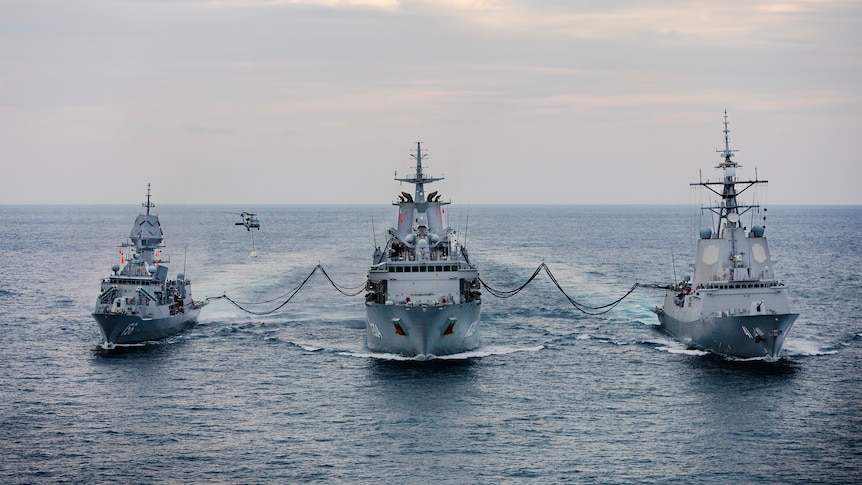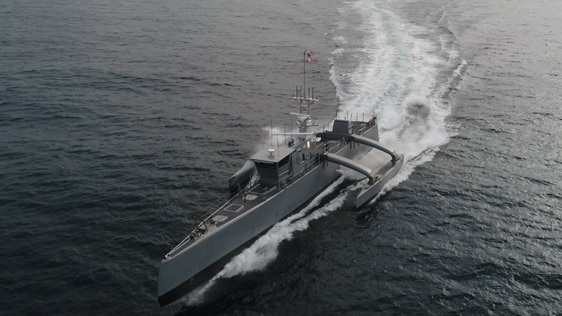The Australian naval fleet reshaping includes the addition of six large naval vessels, which can be crewed optionally and are equipped with a significant number of missiles. This transformation, costing $11 billion, will also involve acquiring 11 new general-purpose frigates, with some of the construction to take place abroad.
Understanding the Transformation of Australia’s Naval Fleet
Discover the ongoing evolution of the Australia naval fleet reshaping and the significant changes it entails. If terms like frigates, AWDs, and OPVs sound unfamiliar to you, fret not. Here’s a comprehensive overview of the current composition of Australia’s surface naval fleet and the anticipated modifications under the government’s latest strategic blueprint.

**Australia Naval Fleet Reshaping: Labor Reveals Enhanced Combatant Fleet**
Labor has introduced its highly anticipated “Enhanced Lethality Surface Combatant Fleet,” featuring six Hunter-class frigates, a reduction from the initial plan of nine. Additionally, the existing Hobart-class destroyers will undergo upgrades, including the integration of Tomahawk cruise missiles.
The comprehensive overhaul aims to increase Australia’s combat-ready warship fleet from 11 to 26 vessels. This expansion includes nine “Tier 1” frigates and destroyers, 11 smaller general-purpose frigates, and six optionally crewed vessels forming a “Tier 2” force.
According to Defence Minister Richard Marles, while the optionally crewed vessels have the capability to operate unmanned, Australia’s preference is to have crews onboard.
The retirement of Australia’s oldest active warship, HMAS Anzac, will precede the gradual replacement of the aging Anzac-class fleet with new frigates to be initially constructed in Germany, Korea, Japan, or Spain.
The planned number of Offshore Patrol Vessels being constructed in Western Australia will be reduced to six, eventually becoming part of a fleet of 25 minor war vessels primarily consisting of Evolved Cape Class patrol boats.
The government plans to evaluate the replacement of the Hobart-class destroyers in alignment with the 2026 National Defence Strategy to support a continuous naval shipbuilding strategy at Adelaide’s Osborne Naval shipyard.
During the unveiling at Sydney’s Garden Island Naval base, Mr. Marles emphasized that the plan is fully funded, injecting an additional $1.7 billion over the forward estimates and $11.1 billion over the next decade into defence.
Mr. Marles stated, “The enhanced lethality surface combatant fleet will ensure the navy is optimized for operations in our current and future environment, supported by the thorough assessment conducted by the Independent Analysis Team.”
Defence Industry Minister Pat Conroy highlighted the necessity for a robust, sovereign defence industry to support the significant advancement in navy capability outlined in the plan.
Vice Admiral Mark Hammond, Chief of Navy, described the initiative as a substantial investment and challenge for the navy to enhance its capabilities and deliver effectively.
“This will be the largest surface combatant force we’ve operated in generations. It will also be, in time, the most lethal,” Vice Admiral Hammond emphasized.
In response, Coalition defence spokesman Andrew Hastie criticized Mr. Marles for not securing additional short-term funding, citing concerns about recruitment and retention within the navy.
Hastie raised questions about Labor’s strategy to address the recruitment and retention crisis affecting morale and the need to attract and retain talented young Australians to crew future submarines and the expanded fleet.
Experience the Australia Naval Fleet Transformation in Real Time
Australia’s Naval Fleet Undergoing Transformation
Australia’s Naval Fleet Undergoes Major Transformation
Australia’s Naval Fleet Undergoing Restructuring
How will the workforce be sourced for the Australia naval fleet reshaping?
Reshaping of the Australian Naval Fleet
Australia Naval Fleet Reshaping: HMAS Anzac Decommissioning Announced
Australia naval fleet reshaping has taken a significant step with the announcement of the decommissioning of HMAS Anzac. This decision marks a pivotal moment in the strategic restructuring of the country’s maritime defense capabilities. The retirement of HMAS Anzac reflects the evolving needs and priorities of Australia’s defense forces in the modern era.
The decommissioning of HMAS Anzac underscores the Australian Navy’s commitment to adapt to emerging security challenges and technological advancements. This strategic move aligns with the nation’s proactive approach to enhancing its naval capabilities and operational effectiveness. The retirement of HMAS Anzac symbolizes a shift towards a more agile and technologically advanced naval fleet.
Please visit our site 60time.com for more updates on Australia’s naval fleet reshaping. And please don’t forget to follow us on social media at Facebook for the latest news and insights.



